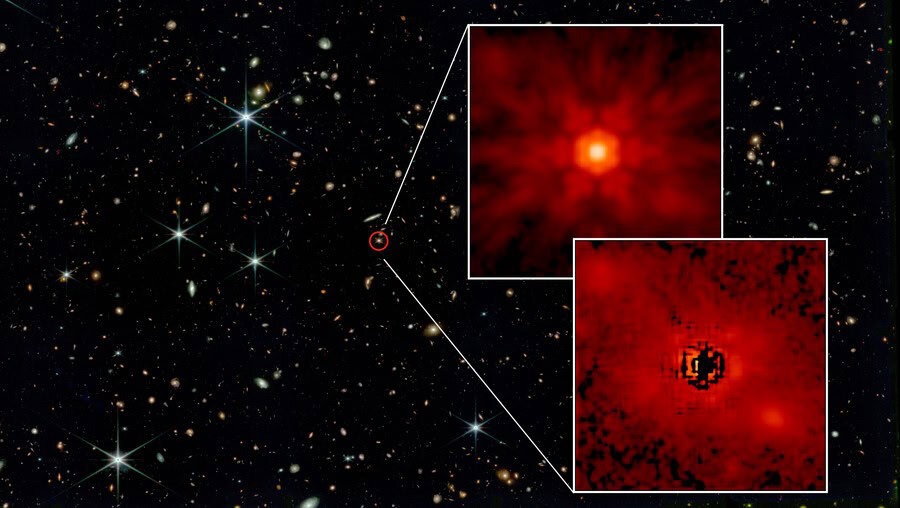
By Sam Jarman 17 Sep 2024
Collected at: https://physicsworld.com/a/dark-matter-decay-could-have-given-ancient-supermassive-black-holes-a-boost/
The decay of dark matter could have played a crucial role in triggering the formation of supermassive black holes (SMBHs) in the early universe, according to a trio of astronomers in the US. Using a combination of gas-cloud simulations and theoretical dark matter calculations, Yifan Lu and colleagues at the University of California, Los Angeles, uncovered promising evidence that the decay of dark matter may have provided the radiation necessary to prevent primordial gas clouds from fragmenting as they collapsed.
SMBHs are thought to reside at the centres of most large galaxies, and can be hundreds of thousands to billions of times more massive than the Sun. For decades, astronomers puzzled over how such immense objects could have formed, and the mystery has deepened with recent observations by the James Webb Space Telescope (JWST).
Since 2023, JWST has detected SMBHs that existed less than one billion years after the birth of the universe. This is far too early to be the result of conventional stellar evolution, whereby smaller black holes coalesce to create a SMBH.
Fragmentation problem
An alternative explanation is that vast primordial gas clouds in the early universe collapsed directly into SMBHs. However, as Lu explains, this theory challenges our understanding of how matter behaves. “Detailed calculations show that, in the absence of any unusual radiation, the largest gas clouds tend to fragment and form a myriad of small halos, not a single supermassive black hole,” he says. “This is due to the formation of molecular hydrogen, which cools the rest of the gas by radiating away thermal energy.”
For SMBHs to form under these conditions, molecular hydrogen would have needed to be somehow suppressed, which would require an additional source of radiation from within these ancient clouds. Recent studies have proposed that this extra energy could have come from hypothetical dark-matter particles decaying into photons.
“This additional radiation could cause the dissociation of molecular hydrogen, preventing fragmentation of large gas clouds into smaller pieces,” Lu explains. “In this case, gravity forces the entire large cloud to collapse as a whole into a [SMBH].”
In several recent studies, researchers have used simulations and theoretical estimates to investigate this possibility. So far, however, most studies have either focused on the mechanics of collapsing gas clouds or on the emissions produced by decaying dark matter, with little overlap between the two.
Extra ingredient needed
“Computer simulations of clouds of gas that could directly collapse to black holes have been studied extensively by groups farther on the astrophysics side of things, and they had examined how additional sources of radiation are a necessary ingredient,” explains Lu’s colleague Zachary Picker.
“Simultaneously, people from the dark matter side had performed some theoretical estimations and found that it seemed unlikely that dark matter could be the source of this additional radiation,” adds Picker.
In their study, Lu, Picker, and Alexander Kusenko sought to bridge this gap by combining both approaches: simulating the collapse of a gas cloud when subjected to radiation produced by the decay of several different candidate dark-matter particles. As they predicted, some of these particles could indeed provide the missing radiation needed to dissociate molecular hydrogen, allowing the entire cloud to collapse into a single SMBH.
However, dark matter is a hypothetical substance that has never been detected directly. As a result, the trio acknowledges that there is currently no reliable way to verify their findings experimentally. For now, this means that their model will simply join a growing list of theories that aim to explain the formation of SMBHs. But if the situation changes in the future, the researchers hope their model could represent a significant step forward in understanding the early universe’s evolution.
“One day, hopefully in my lifetime, we’ll find out what the dark matter is, and then suddenly all of the papers written about that particular type will magically become ‘correct’,” Picker says. “All we can do until then is to keep trying new ideas and hope they uncover something interesting.”
The research is described in Physical Review Letters.

Leave a Reply